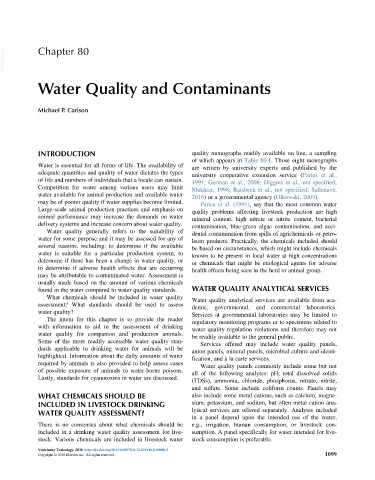Page 1167 - Veterinary Toxicology, Basic and Clinical Principles, 3rd Edition
P. 1167
VetBooks.ir Chapter 80
Water Quality and Contaminants
Michael P. Carlson
INTRODUCTION quality monographs readily available on line, a sampling
of which appears in Table 80.1. Those eight monographs
Water is essential for all forms of life. The availability of
are written by university experts and published by the
adequate quantities and quality of water dictates the types
university cooperative extension service (Faries et al.,
of life and numbers of individuals that a locale can sustain.
1991; German et al., 2008; Higgins et al., not specified;
Competition for water among various users may limit
Mukhtar, 1998; Raisbeck et al., not specified; Sallenave,
water available for animal production and available water
2016) or a governmental agency (Olkowski, 2009).
may be of poorer quality if water supplies become limited. Faries et al. (1991),say that themost common water
Large-scale animal production practices and emphasis on
quality problems affecting livestock production are high
animal performance may increase the demands on water
mineral content, high nitrate or nitrite content, bacterial
delivery systems and increase concern about water quality.
contamination, blue-green algae contamination, and acci-
Water quality generally refers to the suitability of
dental contamination from spills of agrichemicals or petro-
water for some purpose and it may be assessed for any of
leum products. Practically, the chemicals included should
several reasons, including: to determine if the available
be based on circumstances, which might include chemicals
water is suitable for a particular production system, to
known to be present in local water at high concentrations
determine if there has been a change in water quality, or
or chemicals that might be etiological agents for adverse
to determine if adverse health effects that are occurring
health effects being seen in the herd or animal group.
may be attributable to contaminated water. Assessment is
usually made based on the amount of various chemicals
found in the water compared to water quality standards. WATER QUALITY ANALYTICAL SERVICES
What chemicals should be included in water quality
Water quality analytical services are available from aca-
assessment? What standards should be used to assess
demic, governmental, and commercial laboratories.
water quality?
Services at governmental laboratories may be limited to
The intent for this chapter is to provide the reader
regulatory monitoring programs or to specimens related to
with information to aid in the assessment of drinking
water quality regulation violations and therefore may not
water quality for companion and production animals.
be readily available to the general public.
Some of the more readily accessible water quality stan-
Services offered may include water quality panels,
dards applicable to drinking water for animals will be
anion panels, mineral panels, microbial culture and identi-
highlighted. Information about the daily amounts of water
fication, and a ` la carte services.
required by animals is also provided to help assess cases
Water quality panels commonly include some but not
of possible exposure of animals to water-borne poisons.
all of the following analytes: pH, total dissolved solids
Lastly, standards for cyanotoxins in water are discussed.
(TDSs), ammonia, chloride, phosphorus, nitrate, nitrite,
and sulfate. Some include coliform counts. Panels may
WHAT CHEMICALS SHOULD BE also include some metal cations, such as calcium, magne-
INCLUDED IN LIVESTOCK DRINKING sium, potassium, and sodium, but often metal cation ana-
lytical services are offered separately. Analytes included
WATER QUALITY ASSESSMENT?
in a panel depend upon the intended use of the water,
There is no consensus about what chemicals should be e.g., irrigation, human consumption, or livestock con-
included in a drinking water quality assessment for live- sumption. A panel specifically for water intended for live-
stock. Various chemicals are included in livestock water stock consumption is preferable.
Veterinary Toxicology. DOI: http://dx.doi.org/10.1016/B978-0-12-811410-0.00080-5
Copyright © 2018 Elsevier Inc. All rights reserved. 1099

